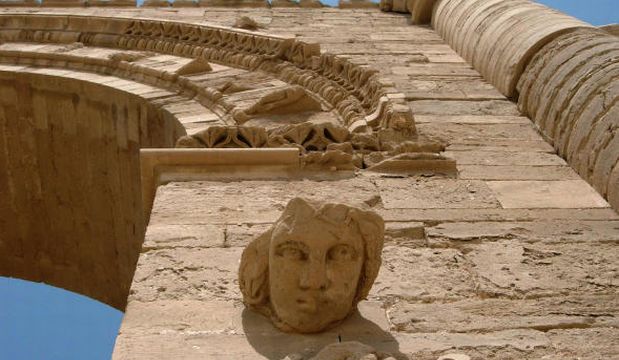
In this July 27, 2005 file photo, the face of a woman stares down at visitors in the Hatra ruins, 200 miles (320 kilometers) north of Baghdad, Iraq. (AP Photo)
Baghdad, Reuters—Iraq urged a US-led military coalition on Sunday to use air power to protect the country’s antiquities from Islamic State of Iraq and Syria (ISIS) fighters looting and destroying some of the world’s greatest archaeological treasures.
A government minister said the coalition, which has carried out 2,800 airstrikes against ISIS military positions in Iraq and Syria since August, was not doing enough to save Iraq’s priceless heritage.
The ultra-radical militants attacked the 2,000-year-old city of Hatra in northern Iraq on Saturday with bulldozers, officials say, days after assaulting the ancient Assyrian city of Nimrud.
Video footage has shown them ransacking a Mosul museum, smashing statues and sculptures.
The destruction has drawn global condemnation, with the United Nations describing the damage to Iraq’s rich history as a war crime. But protests have not halted the rampage.
Iraqi Tourism and Antiquities Minister Adel Shirshab said only the US-led coalition could put an end to the pillaging.
“Our airspace is not in our hands. It’s in their hands,” he told reporters. “I am calling on the international community and coalition to activate its airstrikes and target terrorism wherever it exists.”
Shirshab and the head of Iraq’s state body for antiquities and heritage said Iraqi authorities were still trying to assess the full extent of the damage in Hatra and Nineveh.
“We have confirmation that they bulldozed sites at Nimrud and Hatra. What we don’t have is information about the size of the area which has been razed,” said Qais Rasheed, head of the antiquities board.
Both Rasheed and Shirshab said coalition aircraft could have monitored preparations for the attacks and prevented them, especially at Hatra, a remote desert site about 68 miles (110 kilometers) south of Mosul.
“It was possible to carry out surveillance. Why didn’t this happen?” Shirshab asked.
Archaeologists have compared the assault on Iraq’s cultural history to the Taliban’s destruction of the Bamyan Buddhas in 2001. But the damage wreaked by ISIS in Iraq, where agriculture and writing were pioneered by ancient Mesopotamian civilizations, may have been more devastating.
Last week’s video showed them toppling statues in the Mosul museum and smashing them with sledge hammers and drills. It also showed damage to a huge statue of a bull at the Nergal Gate into the city of Nineveh.
ISIS, which rules a self-declared caliphate in parts of Iraq and Syria, promotes a fiercely purist interpretation of Sunni Islam. It rejects religious shrines of any sort and condemns Iraq’s majority Shi’ite Muslims as heretics.
“Their battle is a battle for identity, to empty the region, primarily Iraq, of its human inheritance,” Shirshab told a conference to mark plans for the city of Babylon to be listed as a world heritage site.
It will join four other Iraqi sites: Hatra, Samarra, the Erbil citadel and Ashur, first capital of the Assyrian empire.
Hatra dates back 2,000 years to the Seleucid empire which controlled a large part of the ancient world conquered by Alexander the Great. It is famous for its striking pillared temple which blends Graeco–Roman and eastern architecture.
